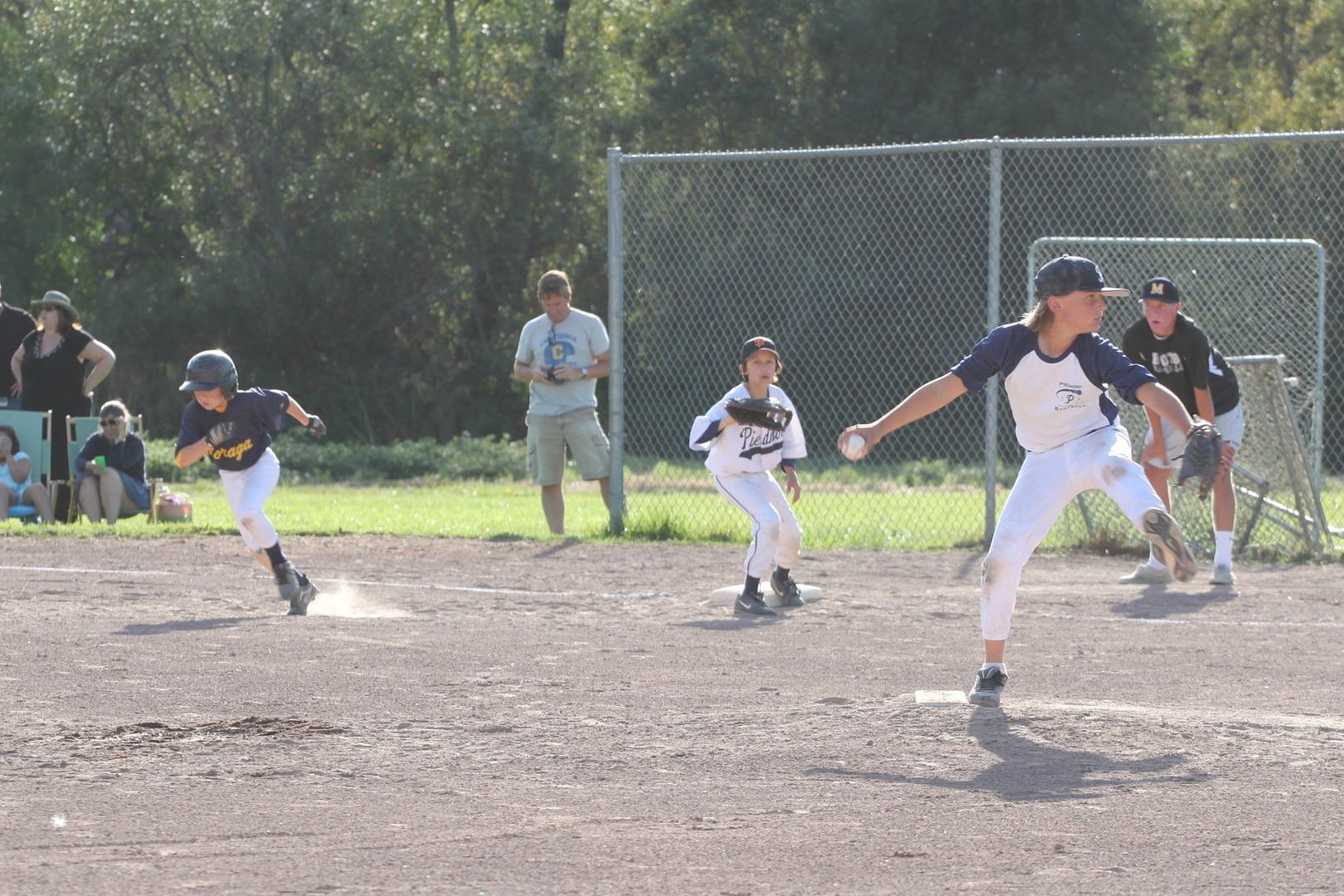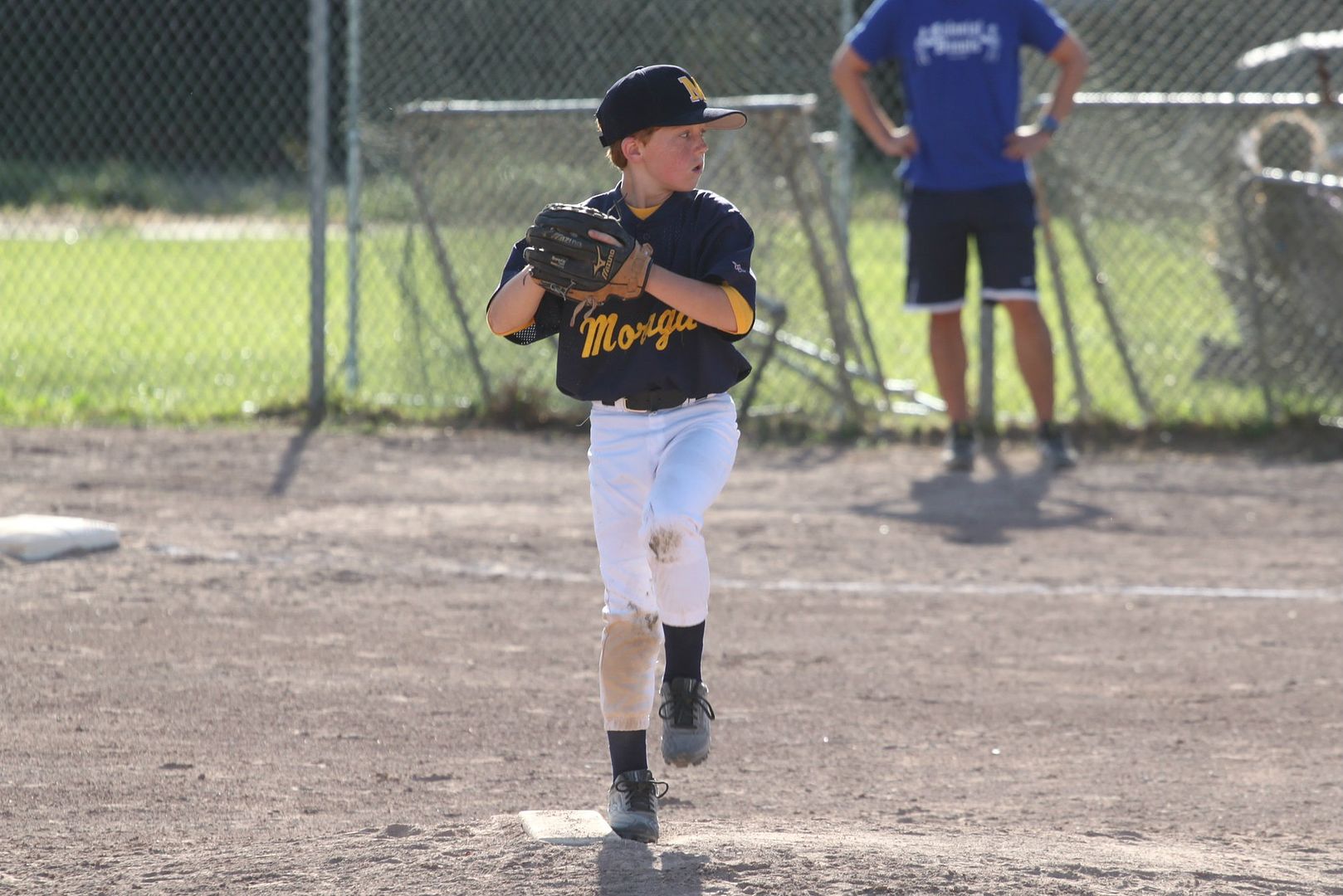After a year hiatus, Michael is playing fall baseball
again. He is moving up a division,
playing on a larger field with older teammates and opponents, and fall ball
provides a relatively low-stress opportunity to adjust to the new
surroundings. Our league's fall ball
program is intended to be a developmental league. We play teams from the neighboring
communities of Orinda and Piedmont, but the game results are not recorded and
standings are not kept.
Over the summer, Michael and I spent some time hitting,
pitching and fielding on the larger field, but nothing can substitute for the
game-time experience, especially when you find out that what would have been
easy double last year is now a close play at first. This is also the division (11 and 12-year-old
boys) when the divide between little boys and fiercely adolescent men-to-be is
the most stark. In our last game, half
the other team's players were bigger than our biggest kid. In game before that, I saw somebody in the opposing
team’s on deck circle for the other team that I would have sworn was a
coach. He had muscles! (And I think drove the team home in his van.) Although he is growing quickly, Michael
remains one of the little guys, so it is just a little alarming to see him face
these relative behemoths.
Our league has divided up the fall ball participants into
three teams: a travel team for 12-year-olds, a travel team for 11-year-olds,
and a team of the remaining players that plays locally. The travel teams were selected through a
tryout process, and are essentially all-star teams with a few additional
players thrown in. Those teams play a
weekend tournaments throughout the fall.
We decided that Michael would not try out for the 11u team, even though
I figured there was a very good chance he could make the team. I expected several of the players from the
summer all-star team to either play other sports that conflict with baseball or
simply choose not play baseball in the fall.
That would open up a few roster spots, and given that Michael was one of
the top 10-year-olds who was not on the travel team this summer, he was pretty
close to a shoe-in. Having now seen the
fall 11u team, which includes one of the least capable players from our spring
team as well as another couple of players who did not make any of the tournament
teams in the spring, it is clear that Michael could have been on the team. However, by the time the league announced its
fall schedule, Michael had already committed to playing soccer, and we all
(Michael most of all) wanted to honor that commitment. It also does not break our hearts to not have
to travel for weekend tournaments in such garden spots as Modesto and Sacramento
(although the tournament in Sunnyvale last weekend might have been fun).
Because the two travel teams siphon off the top players, the
team that plays locally during the fall is a motley collection of mid-range
players. Made up almost exclusively of 10-
and 11-year-olds (i.e., kids in their first year of this level), they would
probably be at best a mid-range team in the younger division they just played
in last spring. The team is short of
sluggers, pitchers, and baseball instincts in general. However, they are receiving excellent
instruction from their coach, a knowledgeable man who is giving them new
aspects of the game to focus on at each Saturday practice. He is assisted by his two sons, both of whom
play for one of the local high schools.
They bring the unique energy and swagger to the group that I think the
boys enjoy.
Not unexpectedly, the team has yet to tally a win after four
games. The competition they face each
week varies widely. The Piedmont team we
played this past weekend was (as I noted above) huge. Our little guys were, for the most part, no
match for their physically much more mature players. On the other hand, they had a few kids at the
bottom of the lineup that were younger and not as capable, and our kids
competed well with them. The week
before, we played a different Piedmont team that was much more similar to ours
in general distribution of talent and experience. We scored a lot of runs in the game, but they
prevailed in the end in a very entertaining contest.
For his part, Michael is playing well and having a good
time.
He is often the shortstop, and is
also one of the regular pitchers.
Because he throws strikes better than anyone else on the team, the coach
has taken to calling him his "closer," bringing him in at the end of
games.
Sometimes that works, sometimes
it doesn't.
Two weeks ago, when we were
clinging to a one-run lead, Michael did what he does, which is throw
strikes.
The other team put the bat on
the ball, and ended up scoring four runs to win the game.
However, none of the balls they hit left the
infield.
With more experienced players,
we would have been out of that inning with a couple of ground outs and
strikeout.
As it was, there were several
missed opportunities to make easy outs. (To be fair, as I reminded him after
the game, Michael cost his starting pitcher two runs at the very beginning of
the game with some uncharacteristically poor play at second base.
Learning the give and take of picking up your
teammates when you make mistakes and maintaining poise when they fail is a big
part of baseball at this level.)
The coach,
however, was very pleased with the way Michael pitched because he went after
the hitters.
This past week, Michael
pitched in the last inning of a blowout.
His first batter had hit two triples earlier in the game.
Michael got a called strike, another strike
on a weak foul ball, and struck him out.
He retired the next (humongous) batter on a ground ball to shortstop,
who got an easy force out at third.
At the plate, Michael has been the leadoff hitter all season
and has gotten a hit in every game so far (as fact he never fails to point out
to me).
He has stolen several bases and
scored several runs.
 |
| The runner goes! |
 |
| Flying around third on the way to scoring a run |
He even came
through in the clutch this weekend, for his personal stats.
Going into his last at-bat, he was 0-for-1 with
a walk, with his hit streak on the line.
Facing a new pitcher who was at least a head taller than he, he worked
the count, as he always does.
After
watching a couple of balls go by, he fouled off a pitch up in his eyes, then
took a called strike that was even higher.
He couldn't hide his frustration at what we call the "fall ball strike
zone," but he showed his development as a player with the next pitch.
It was also up in his eyes (I have
photographic proof below), but he went up to meet the pitch and drove it sharply into
right field.
He promptly stole second and scored shortly
thereafter. When we talked after the
game, he confirmed my guess about what he had done:
he told me he swung at pitch precisely because the previous pitch had
been in the same location and had been called strike.
 |
| The classic eye-high fastball |
I am thoroughly enjoying the opportunity to watch Michael and
his teammates play without any burden to coach, prepare, instruct or do
anything other than refill his water bottle and take lots of pictures. I take responsibility, along with a couple of
the other dads, to prepare the field before each game, but beyond that, I am
not needed. I still sit through the two-hour
Saturday practices, not because they need me there to coach or shag balls, but
because I love watching the coaches work and the players play. Those two hours every Saturday afternoon have
turned into one of the most relaxing and enjoyable weekly interludes I have had
a long time.
It doesn't hurt that my
kid, while far from being an athletic prodigy, is a very good player who is
soaking up good coaching and achieving things on the field (six hits in 11
at-bats so far this fall) that have been his goals for himself for a long
time. I love that he is learning some of
the finer points of the game and is physically capable of putting them into
action. As an example, two weeks ago I
noticed that one of the opposing team’s batters stood extremely far from the
plate. Unfortunately, our pitcher threw to where the batter stood, rather than where the plate was, and gave up
a very long base hit. I explained to
Michael after the game what I had seen, and reminded him to pitch to the plate,
which would give him a huge advantage against someone who stood far from
it. This week, when called upon to face
a couple of very capable batters, he noticed (as he told me after the game)
that one of them stood well off the plate.
In response, Michael pitched ball over the outer half of the plate, with
great effectiveness. He turned a player
who had drilled the ball repeatedly earlier in the game to a weak strikeout
victim who could only foul off the ball to the right side with an excuse-me
swing. That is called having a plan and
putting it into action; that kind of craftiness will serve him well as he waits
for his body to develop the size and strength it will need to compete with most
of the other rapidly-developing boys in the division.
 |
| The form is there, and the size will come |
We may not see many wins this fall, but the players will
benefit tremendously from the experience, and will be much more comfortable
going into the regular spring season as a result.



